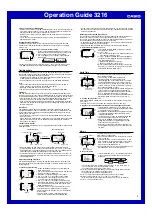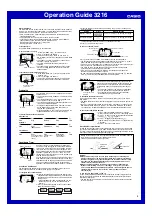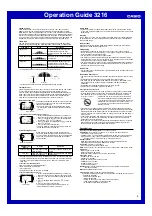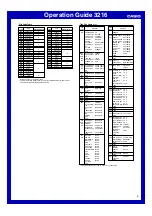
Operation Guide 3216
5
Tidal Movements
Tides are the periodic rise and fall of the water of oceans, seas, bays, and other
bodies of water caused mainly by the gravitational interactions between the Earth,
Moon and Sun. Tides rise and fall about every six hours. The Tide Graph of this watch
indicates tidal movement based on the Moon’s transit over a meridian and the lunitidal
interval. The Tide Graph calculates and graphically represents current tide conditions
in your currently selected site or USER site based on longitudes, lunar day length, and
lunitidal interval preset in watch memory, and on high tide times specified by you.
Tide Graph
The Tide Graph graphically represents the current tide condition using one of three
patterns that represent spring tide, intermediate tide, and neap tide, as shown below.
Large difference between high tide
and low tide. Occurs a few days
before and after a New Moon and Full
Moon.
Medium difference between high tide
and low tide.
Small difference between high tide
and low tide. Occurs a few days
before and after the first quarter and
last quarter of a half moon.
Tide Name
Graph
Description
Spring Tide
Intermediate Tide
Neap Tide
•
The Tide Graph flashes as shown below to indicate the tide range.
•
The segments on either end of the Tide Graph flash during high tide.
Lunitidal Interval
Theoretically, high tide is at the moon’s transit over the meridian and low tide is about
six hours later. Actual high tide occurs somewhat later, due to factors such as
viscosity, friction, and underwater topography. Both the time differential between the
moon’s transit over the meridian until high tide and the time differential between the
moon’s transit over the meridian until low tide are known as the “lunitidal interval”.
Tides data is calculated using the lunitidal intervals preset for each site.
llll
lll
llllll
llll
lll
llllll
High tide
Low tide
Button Operation Tone
The button operation tone sounds any time you press one
of the watch’s buttons. You can turn the button operation
tone on or off as desired.
•
Even if you turn off the button operation tone, alarms,
the Hourly Time Signal, and other beepers all operate
normally.
To turn the button operation tone on and off
1. In the Timekeeping Mode, hold down
A
until the city
code starts to flash, which indicates the setting screen.
2. Press
C
nine times until the current button operation
tone setting (
or
) appears.
3. Press
D
to toggle the setting between
(tone on)
and
(tone off).
4. Press
A
to exit the setting screen.
•
The mute indicator is displayed in all modes when the
button operation tone is turned off.
l ll
ll
ll
ll
ll
l l
l l l
ll
lll
ll
llll
Mute indicator
Power Saving Function
When turned on, the Power Saving function enters a
sleep state automatically whenever the watch is left in an
area for a certain period where it is dark. The table below
shows how watch functions are affected by the Power
Saving function.
Elapsed Time
in Dark
60 to 70 minutes
6 or 7 days
Display
Blank, with Power Saving
indicator flashing
Blank, with Power Saving
indicator not flashing
Operation
All functions enabled, except for the
display
Beeper tone, illumination, and display
are disabled.
•
Wearing the watch inside the sleeve of clothing can cause it to enter the sleep state.
Power saving indicator
•
The watch will not enter the sleep state between 6:00 AM and 9:59 PM. If the watch
is already in the sleep state when 6:00 AM arrives, however, it will remain in the
sleep state.
To recover from the sleep state
Perform any one of the following operations.
•
Move the watch to a well-lit area.
•
Press any button.
•
Angle the watch towards your face for reading.
To turn Power Saving on and off
1. In the Timekeeping Mode, hold down
A
until the city
code starts to flash, which indicates the setting screen.
2. Press
C
11 times until the Power Saving on/off screen
appears.
3. Press
D
to toggle Power Saving on (
) and off
(
).
4. Press
A
to exit the setting screen.
•
The Power Saving indicator is on the display in all
modes while Power Saving is turned on.
On/Off status
l l l l l
ll
ll
lll
ll
ll
ll
ll
l l
Auto Return
•
If you do not perform any operation for about two or three minutes while a setting
screen (with a flashing setting) is on the display, the watch will exit the setting screen
automatically.
Scrolling
The
B
and
D
are used in various modes and setting screens to scroll through data
on the display. In most cases, holding down these buttons during a scroll operation
scrolls at high speed.
Initial Screens
When you enter the World Time Mode or Alarm Mode, the data you were viewing
when you last exited the mode appears first.
Timekeeping
•
Resetting the seconds to 00 while the current count is in the range of 30 to 59
causes the minutes to be increased by 1. In the range of 00 to 29, the seconds are
reset to 00 without changing the minutes.
•
The year can be set in the range of 2000 to 2099.
•
The watch’s built-in full automatic calendar makes allowances for different month
lengths and leap years. Once you set the date, there should be no reason to change
it except after you have the watch’s battery replaced.
•
The current time for all city codes in the Timekeeping Mode and World Time Mode is
calculated in accordance with the Coordinated Universal Time (UTC) for each city,
based on your Home City time setting.
World Time
•
The seconds count of the World Time is synchronized with the seconds count of the
Timekeeping Mode.
Illumination Precautions
•
The electro-luminescent panel that provides illumination loses power after very long
use.
•
Illumination may be difficult to see when viewed under direct sunlight.
•
The watch may emit an audible sound whenever the display is illuminated. This is
due to vibration of the EL panel used for illumination, and does not indicate
malfunction.
•
Illumination turns off automatically whenever an alarm sounds.
•
Frequent use of illumination runs down the battery.
Auto light switch precautions
•
Avoid wearing the watch on the inside of your wrist. Doing so causes the auto light
switch to operate when it is not needed, which shortens battery life. If you want to
wear the watch on the inside of your wrist, turn off the auto light switch feature.
•
Illumination may not turn on if the face of the watch is
more than 15 degrees above or below parallel. Make
sure that the back of your hand is parallel to the ground.
•
Illumination turns off after a preset amount of time (1.5
or 3 seconds), even if you keep the watch pointed
towards your face.
•
Static electricity or magnetic force can interfere with proper operation of the auto
light switch. If illumination does not turn on, try moving the watch back to the starting
position (parallel with the ground) and then tilt it back toward you again. If this does
not work, drop your arm all the way down so it hangs at your side, and then bring it
back up again.
•
Under certain conditions, illumination may not turn on until about one second after
you turn the face of the watch towards you. This does not necessarily indicate
malfunction of the auto light switch.
•
You may notice a very faint clicking sound coming from the watch when it is shaken
back and forth. This sound is caused by mechanical operation of the auto light
switch, and does not indicate a problem with the watch.
More than 15 degrees
too high
Specifications
Accuracy at normal temperature:
± 15 seconds a month
Timekeeping:
Hour, minutes, seconds, p.m. (P), month, day, day of the week
Time format: 12-hour and 24-hour
Calendar system: Full Auto-calendar pre-programmed from the year 2000 to 2099
Other: Home City code (can be assigned one of 48 city codes); Standard Time /
Daylight Saving Time (summer time); Checking a Tide Site
Tide/Moon Data:
Moon phase indicator for specific date; Tide level for specific date and time
Other: High tide time adjustment; Moon phase reversal
World Time:
48 cities (31 time zones)
Other: Daylight Saving Time/Standard Time
Alarms:
5 daily alarms (four one-time alarms; one snooze alarm); Hourly Time Signal
Stopwatch:
Measuring unit: 1/100 second
Measuring capacity: 59' 59.99''
Measuring modes: Elapsed time, split time, two finishes
Countdown Timer:
Number of timers: 2 (one set)
Setting unit: 5 seconds
Range: 99 minutes 55 seconds each timer
Countdown unit: 1 second
Number of repeats: 1 to 10
5-second time up beeper
Illumination:
EL (electro-luminescent panel); Full Auto Light Switch; Selectable
illumination duration
Other:
Button operation tone on/off
Power Supply:
Solar cell and one rechargeable battery
Approximate battery operating time: 11 months (from full charge to Level 4) under
the following conditions:
•
Watch not exposed to light
•
Internal timekeeping
•
Display on 18 hours per day, sleep state 6 hours per day
•
1 illumination operation(1.5 second) per day
•
10 seconds of alarm operation per day
























